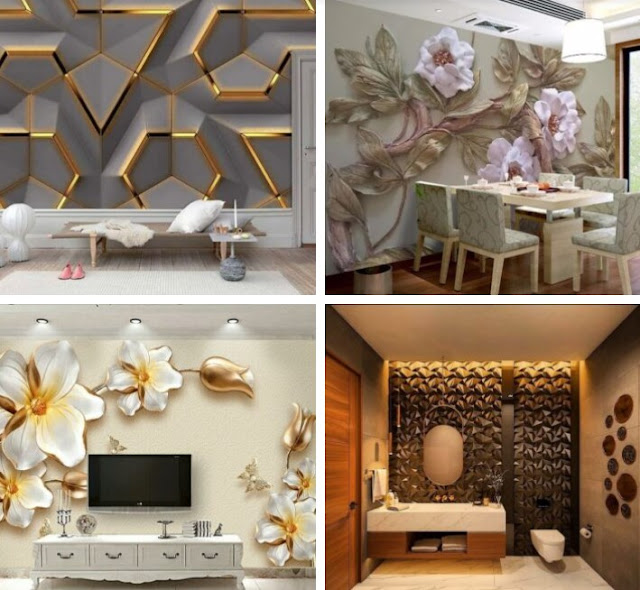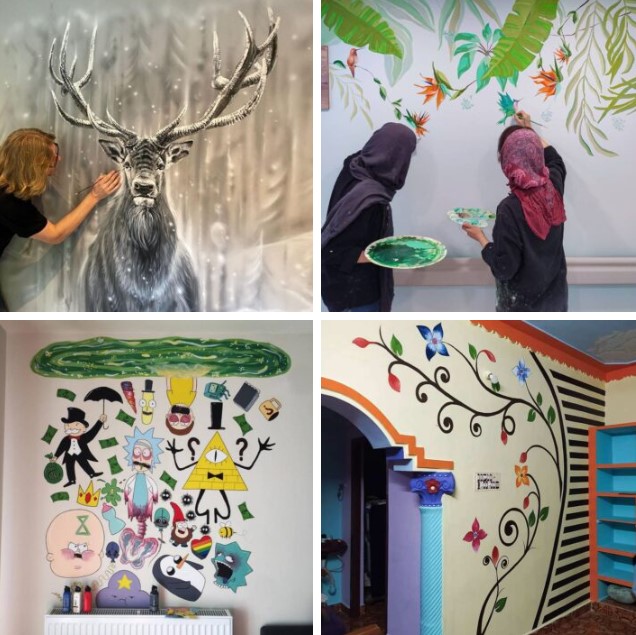Home Design Wall Painting Ideas - What color are your walls? If you're struggling to remember the last time you painted your walls, it's time to update them.
You can buy a large 20-liter bucket of white paint and get to work. But that would be boring. Instead, look at each room as an opportunity to express your taste and personal style.
Our wall painting ideas will show you that there are countless wall art options for your home.
Use your home as a blank canvas for artistic expression with a little imagination and creativity.
So, are you ready to say goodbye to your boring old walls and try one of the suggested mural ideas?
Home Design Wall Painting Ideas
1. 3D
When creating wall art, add depth and dimension with a 3D effect. Using perspective and shadows, paint the illusion that your walls are further away or "deeper" than they are.
Using this wall painting technique is not an easy task. If you think this is above your skill level, look for wallpaper with a pattern that will create a 3D effect for you.
When drawing animals, flowers, leaves, or trees, add depth by using sheer shadows slightly offset from the subject.
To achieve this effect, choose an imaginary point as the light source. Then paint the shadows as they would be if the light really fell on your drawing.
To properly add perspective, you must first measure and outline your painting. Then all lines will be directed to the same distance point.
Remember that objects get smaller as you move away from them.
2. Bedroom
Your bedroom is your personal space. Whatever you decide to hang on the walls is fine if it's what you like.
However, if you need help making a decision, there are a few things you can do to help narrow down your options.
If you have molding, paint it bright white and then choose a darker color for the walls.
Contrasting colors are a crisp and bold look that makes your bedroom seem bigger than it is.
If you have low ceilings, paint the molding the same color as the walls to give the illusion of a higher ceiling.
Choose a color for your bedroom that appeals to you. Colors can influence your mood. Cool colors like blue, green, and purple create a calming environment.
Warm colors like red, orange, and yellow usually create an energetic environment.
However, don't forget the tone; dark red creates a darker mood in the mind than bright fiery red. Then there are neutral colors.
You can create a minimalist look with white or black walls.
3. Design
Create a design with paint to give the room visual interest and color. The easiest way to do this is with horizontal or vertical stripes.
Pick two colors and paint the entire wall the lighter of the two. Use masking tape to mark where the second color will be.
A vertical stripe will make the walls appear taller and the ceiling taller. A horizontal strip will visually increase the length of the room.
Choose two light colors for a softer look. This approach works well in a minimal or white room. The pattern adds depth and texture to the space.
Bolder color combinations with light and dark colors are a bolder statement that will be the center of attention in the room.
4. Geometry
Creating geometric shapes all over the wall is a popular idea for an accent wall.
Most people choose at least two or three different colors for their shapes. However, you can choose as many colors as you like.
The easiest way to create shapes is to use masking tape. Paste it on the wall for the borders of different-sized shapes.
These can be triangles or geometric shapes with a different number of sides.
For a more dramatic look, remove the white lines that masking tape creates by gradually painting the wall.
To do this, you will need to mark out the shapes for the first color. Then, when the first color dries, you will cover the areas of the next color.
Two-tone shades will be opposite each other and eliminate white borders.
5. Girl's room
A girl's room is the perfect place to get creative and add some sparkle or glam to the walls.
Start by painting the walls the color she likes. You can decorate the walls with stickers. Polka dot stickers look very nice.
Stickers can be evenly placed across the entire wall. Or you can place them closer together at the top of the wall and gradually move them apart as you move down the wall to create the illusion of fading.
If she's creative, paint one of the walls with chalkboard paint. This technique will create an entire wall in the form of a chalkboard, perfect for drawing or creating your own drawings. When she gets tired of her creations, she can erase them and start over.
See other articles:
- painting ideas aesthetic
- simple geometric wall design
- feng shui wall art living room
- easy diy wall mural ideas
- house hall painting colours
6. Inner wall
The safest interior paint palette is neutral colors. It can be anything from pure white to shades of cream and beige. These colors are light, reflect light well, and look great with whatever design aesthetic you choose. They are also universally attractive and pleasing to the eye.
Bold homeowners can ditch neutral colors and create a colorful pieces of art on their walls. Turn a large empty space into a wall mural. Use a few bright colors to paint a custom pattern that fills the entire wall.
This is a good idea if you don't plan on placing anything else on the wall. You should not try to create a "gallery wall" on top of the fresco. Wall paint and your photo collection will compete with each other.
7. Ombre
When you hear about ombre, it usually refers to the hair, but this is not the only place where you can enjoy ombre. The idea is to mix several color combinations together for a smooth transition from one color to another. To look your best, start with the darkest color at the bottom of the wall and get lighter as you move up to the ceiling.
When painting an ombre wall, two techniques can be used. The first is to apply horizontal stripes to the main body of the wall, leaving space between each color. Then quickly, before the paint has had time to dry, mix the colors together to create a new color. Then with a brush, apply this color to the wall in between.
Another option is to use the lightest color to apply the base coat to the entire wall. Then dilute the other colors to create a washed-out color that gradually gets darker and more opaque the further you go down the wall.
8. Spray paint
Not all paints come in cans and are then applied to the wall with a brush or roller. Give your walls an urban look with spray paint. The method requires practice and skill, so it's best to practice a few times in advance on a different surface before trying to paint the walls.
You can use a stencil. It will save you the need for a steady hand and dexterity. You can also look for a drawing that inspires you. Then draw it on the wall, using it as a guide to creating your own piece of art.
Spray paint can be toxic and requires a well-ventilated area for use. It can also be very dirty. It is best not to spray paint on exterior walls. Then there will be enough space and ventilation. It is also not scary if you drip onto the floor during the painting process.
9. Wood
Paint a tree on the wall so you can bring nature into your home. This is an ideal solution for those who do not really like plants or live in a room where there is no good lighting. Perhaps you have a room that doesn't get a lot of sunlight, and it would be difficult for a real plant to thrive in that room.
Draw a tree on the wall and get a plant that will never die. Add flowers and you will enjoy colorful blooming flower buds all year round.
While this is one of the most popular creative wall painting ideas, it is not easy to bring to life. Use a stencil for the trunk and branches. Then another one for the leaves. To give the tree a realistic look, add fine detail and texture by adding bark to the trunk and veins to the leaves.
10. Two colors
Add some color to the room by painting the walls in two colors. Choose two complementary colors. Then use the darker color on the bottom of the wall and the lighter color on the top. The paint colors you choose should look good together. Possible color combinations: black and white, yellow and peach, deep teal and cream, or plum and lilac.
A simple approach is to split the wall in half and paint the bottom half one color and the top half another. However, you can create a unique look by painting most of the walls in one color and only a small part in another. In this case, the second color will be more like an accent color.
11. DIY
What's most interesting about painting is that you have the freedom to be as simple or as creative as you want. Paint, rollers, and masking tape are at your disposal. View your empty wall as a large canvas.
If you are afraid to overdo it or are not prone to creativity, limit yourself to creating an accent wall. Paint all but one wall the same color. Then, on the last wall, create a design that turns the wall into an accent wall.
One approach is paint treatment; use a sponge, icing, color wash, strip, or rag roller. These funds are applied to the entire wall. Another approach is to use masking tape to create the pattern. It can be abstract geometric shapes or a wall painting of mountains or a tree.
12. Outer wall
Painting the outside of your home is a unique task that you don't have to worry about when choosing interior paint. The outside of the house is exposed to weather conditions, temperature changes, sun, wind, and animals. The paint needs to look nice and be strong enough to last a long time.
Look for acrylic paint with UV blockers. They will help prevent fading, cracking, and peeling. For greater durability, first, apply an acrylic primer and then paint. It will provide the best appearance and the most saturated color shade.












